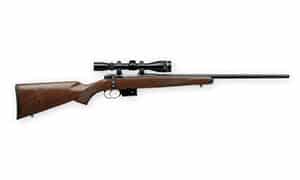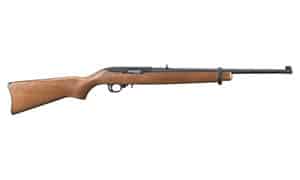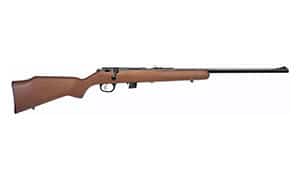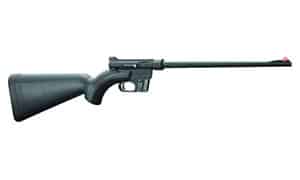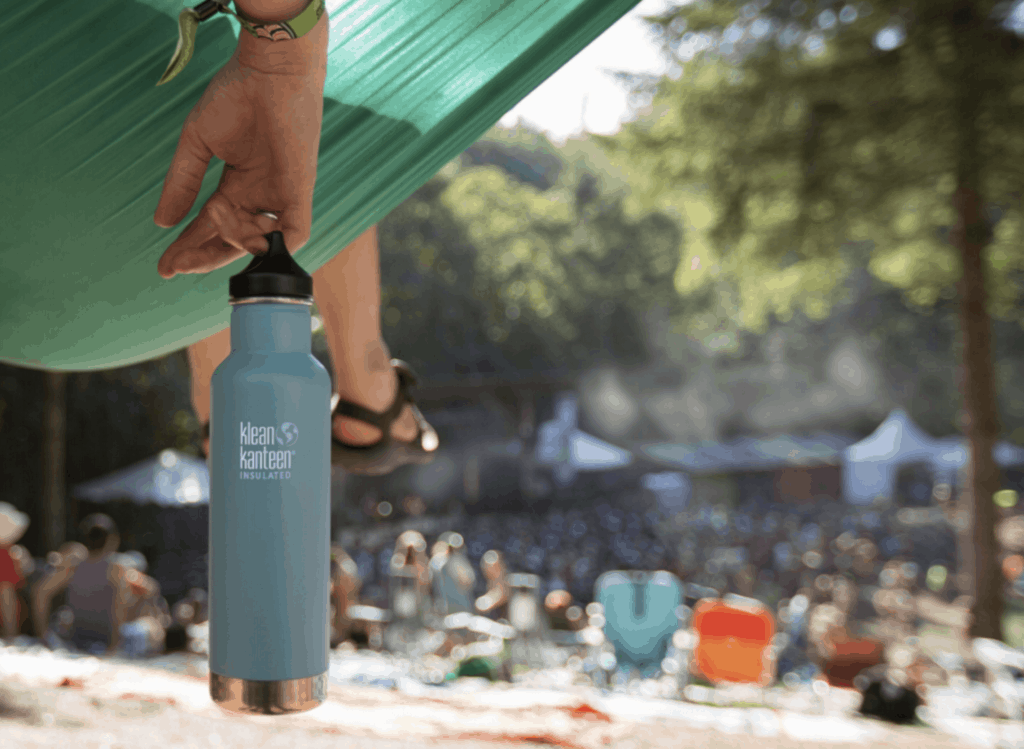The .22 rifle is a great multi-purpose gun. The debate about the best .22 rifle (1) seems to never end. Just when there seems to be a clear favorite someone introduces a variation on an existing gun that reshuffles the cards. Either that or .22s are just summarily dismissed as not being “real” full-size rifles. But while the purists argue minutia the people speak with their dollars and cents with .22 rimfire ammunition still being the most purchased in the USA.
So we have reviewed and ranked the best .22 rifles.
1. CZ 527 American Rifle
The 527 American Rifle from CZ is an extremely handsome gun with a black chrome barrel, detachable 4-shot magazine, walnut stock with pistol grip and the company’s signature single set trigger. That stock has a very pleasing look and feel with a deep, rich finish and ergonomic shape with a rubber butt pad that rests against your shoulder like a tailored jacket. The light profile barrel is hammer forged (2) with a recessed crown target. And with the right high-end ammo the accuracy is fairly astonishing.
As we mentioned it also features what is becoming one of the company’s trademarks; the adjustable single set trigger. You have the option to use the standard hunting trigger or the light target trigger with the standard hunting trigger being the heavier of the two pulls. Switching from one to the other is as simple as pushing the trigger forward until you hear the click.
The hunting trigger can be adjusted for creep, over-travel and, as we mentioned, weight. The target trigger however can only be adjusted for weight. In either case though you’re sure to be pleased with what’s presented to you. All in all the CZ 527 is a pretty amazing production rifle sure to satisfy both newcomers and grizzled rifle vets.
2. Ruger 10/22 Sporter, Semi-Automatic, .22LR
The 10/22 from Ruger has been with us for 55 years selling millions of units and becoming an indelible part of the firearms landscape. It began attracting fans the minute it hit gun store shelves in 1964 and has never seen a significant dip in its popularity since. Bill Ruger wanted his gun to reflect his design ethos of being comfortable, affordable and aesthetically pleasing to boot.
There’s not a lot of things you can say about the 10/22 that haven’t already been said thousands of times. But we’re not above a bit of dry recitation of its many virtues. For starters it’s an ideal gun for small game hunting. It’s also perfect for teaching newcomers the essentials of handling and shooting a firearm due to its light weight, modest size and easy to take recoil.
The stock 10 round magazine is fine for hunting those small critters although you have the option to pick up larger capacity magazines as well. Some as large a 110 rounds. (It’s unlikely you’re going to need anything that size unless you have one serious squirrel infestation.) On the whole though the 10/22 has earned its place in the collective consciousness and as long as the company remains committed to the same quality control standards it’s likely to stay there.
3. Marlin XT-22
The recently introduced XT-22 is said to reflect the company’s renewed commitment to the venerable .22. While there’s nothing particularly revolutionary about the profile that new approach can be seen in some of the details. For instance, the walnut stock has undergone a few small but important tweaks that make it more comfortable than ever. While the re-engineered bolt mechanism is machined to exacting tolerances and provides some of the smoothest, most reliable action you’ll get in any .22 bolt action rimfire rifle.
The open sites that come with the rifle are actually quite effective and are likely to make more than a few owners think twice before plunking down their hard-earned money on an expensive scope. When those stock sites are combined with the micro-rifling in the barrel you end up with a gun that is incredibly accurate right out of the box.
The XT-22 is an ideal gun for hunting small game. And that accuracy we touched on above really comes to the fore during target practice. The XT-22 comes with a 7 shot magazine, Pro-Fire adjustable trigger so you can find just the right pressure, a thumb safety and a blued barrel to ward off corrosion. If you decide to go the scope route the gun is drilled and tapped for that purpose.
4. Marlin Model 60 Semi-Automatic .22LR
The Model 60 is another iconic American firearm that’s been in continuous production since the Kennedy/Nixon debates. (That would be 1960 for the historically-challenged.) Perhaps surprisingly not much has changed since those sepia-toned days of yesteryear save for the introduction in 1985 of a mechanism to lock the bolt halfway open when the magazine is empty. And the fact that at about the same time the company reduced the magazine from 18 to 14 rounds and cut 3 inches off the barrel.
Beyond that this is essentially the same gun your grandfather would have purchased almost 6 decades ago. And it remains as insanely popular as ever because of its simple reliability, its generally outstanding accuracy and its affordability.
That accuracy is largely a function of the peerless balance of the gun combined with the 16-groove micro rifling. Whether you’re small game hunting or just getting in some target practice with the kids this is a great rifle to have in the gun case.
5. Henry Survival AR-7 Semi-Automatic .22LR Rimfire
The Henry Survival AR-7 is descended from the original ArmaLite AR-5 design developed for the Air Force way back in 1959. The AR-7 was designed by the same man – Eugene Stoner – who designed the AR-15. That gun would later become the legendary M-16 (3) of US Armed Forces fame.
The AR-7’s claim to fame was/is its compact design. It quickly and easily breaks down into 4 component parts with the longest being the 16 inch barrel. Broken down it stows away easily in a backpack (a prerequisite for a survival rifle for air crews and the like). It’s also light. Tipping the scales at a very modest 3 1/2 pounds.
These days the AR-7 is manufactured by Charter Arms and ArmaLite as well as Henry. We prefer the Henry because of the slightly higher grade material used in the stock. If you’re looking for a survival rifle you can easily tote into the backcountry here it is.
6. Savage Mark II GL
The last of our best .22 rifles is this beauty from Savage. The Mark II has weathered waxing and waning tastes for decades for a number of reasons. But mostly because of its rock solid build quality and oh-so-friendly price point. Because we’re open-minded folks we’re profiling the lefty version of the Mark II. Because left handers need bolt action rifles too.
There’s nothing groundbreaking about the Mark II. It features a conventional bolt action and a 10 round detachable magazine. And while the trigger isn’t going to win any awards it’s nonetheless perfectly suitable for bagging squirrels and other small game.
One thing that does set the Mark II apart from similarly priced competitor models is the wide range of available stocks that allow you to achieve at least a bit of customization. The Mark II is drilled and tapped for scope and ready to take its place as your everyday small game rifle.
FAQs
Why Would Anyone Want a .22 Rifle?
Maybe a better question than what is the best .22 rifle is this: Why would anyone want a .22 rifle in the first place? It’s certainly a question with fewer potential variables which would lead one to believe it also has a more clearly defined and fixed answer. So let’s take a shot at it.
First off, we’ll concede the obvious points.
- A .22 is not going to scare off many heavily armed assailants.
- A .22 is not powerful enough to kill large game in a humane fashion (4).
- You aren’t going to have much luck duck hunting with a .22 for lack of range.
Those truths aside there is still plenty of room for the .22 to carve out a useful space for itself in the pantheon of firearms. Here are just some of the reasons you should have one of the best .22 rifles in your personal arsenal.
- They’re ideal for hunting small game including, squirrels, rabbits, opossums and more.
- They’re a perfect tool for survivalists and preppers who understand survival is as much about hunting what’s available as it is about fighting off hordes of the undead.
- They’re an ideal recreational firearm. While the footsoldiers of Beelzebub won’t be too impressed with a .22 you can still take it to the range for a nice relaxed afternoon of target shooting.
- And because these weapons produce such modest recoil (5) you can also bring the young ones with you and teach them the proper ways to shoot and handle a firearm.
So while it’s a given that the .22 rifle won’t provide you much cover in the event of societal breakdown they’re still a great entry level “real” weapon. They’re an ideal teaching tool and they’re the perfect weapon for small game of all kinds.
Fixed or Detachable Magazine?
The magazine is that part of the rifle that stores additional ammo for loading into the chamber. Different .22 rifles have different size chambers with varying capacities. You can optimize the rifle for different purposes (at least to a limited extent) by changing the magazine. That said magazines fall into one of two categories; either fixed or detachable.
- Fixed magazines are going to take longer to reload but there’s no doubt they make things simpler. They also prevent the possible loss of the magazine. Fixed magazines also don’t make any rattling noise while you’re walking that might scare away game.
- Lots of gun owners love the detachable magazine because it enables them to reload on the fly. However, as we just mentioned, magazines can get lost. They also have a tendency to fail after repeated use. So if you’re to be truly prepared for any eventuality you’ll need to have multiple magazines on hand at any given time.
Wood or Synthetic Stock?
The wood stock is of course iconic. When people think of hunting rifles there thoughts invariably go to images of beautiful hardwood stocks. And for good reason. For as much as a rifle may be a tool it’s also as much a work of art as a samurai sword. Even when you’re not firing your .22 you can still appreciate the look and feel of the wood and admire its timeless qualities. That’s a bit harder to do when you’re talking about synthetic stocks, which tend to have all the personality and soul of a plastic bag.
Still, just as plastic bags have their upside so too does the oft-maligned synthetic stock. Whereas a wooden stock will be susceptible to warping, cracking and being nicked and chipped that’s not going to happen with a synthetic stock. Another thing to consider is the weight. If you’re toting your rifle miles into the backcountry the difference a few pounds makes over that distance can be considerable. So if you plan on taking your rifle out a lot you may be better served with a synthetic stock.
What’s the Best Scope for a .22 Rifle?
Adjustable Objective vs Side Focus Parallax Scopes
- Side focus scopes tend to be heavier than AO scopes. Parallax adjustment (6) tends to be a bit easier too since it’s always easily within reach.
- Adjustable objective scopes tend to be smaller and lighter, contain fewer parts and are typically less expensive than side focus parallax scopes. However, because the adjustment mechanism is located at the front of the scope it’s difficult if not impossible to adjust it while lying down. As such this type of scope is normally used for firing a fixed distance.
Because they can be adjusted so much easier the side focus parallax scope is better for tactical situations in both real life and competitions. Adjustable objective scopes on the other hand are advised for bench rest shooters who aren’t going anywhere and neither is their target. For hunting of course you’d want the side focus parallax scope because that rabbit is not necessarily going to cooperate and sit perfectly still.
Semi-Automatic or Bolt Action?
Honestly there is no clear cut winner in this competition. Both types have their upside and downside. Let’s look at some of those.
- Accuracy – Some argue that AR-15’s and bolt action rifles produce more or less the same level of accuracy. A majority however, would argue that it’s easier to produce an accurate shot with a bolt action. That’s because there’s fewer moving parts with the bolt action. Just close the bolt and that’s it. With an AR the bolt moves twice both to open and then return. You typically see more bolt action rifles being used in competitions.
- Number of components – A semi-automatic, while not a complex gun, is nonetheless more complicated than the standard bolt action with more parts. The various components of the AR bolt mechanism each add another potential point of fail to the mix and each can have some small influence on accuracy.
- Speed – There’s no doubt that shooting a semi-automatic rifle is faster than a bolt action. It should be. That’s likely the primary reason you’re buying it. ARs do all the work for you. You can simply maintain your position and continue to fire as long as the ammunition holds out. Simply point and shoot, track and repeat.
- Controls – With a bolt action you’re going to be dealing with either right or left hand controls. But there are no such concerns with a semi-automatic. They’re completely ambidextrous. You can shift the rifle from side to side or change to different positions with ease. In reality though most people won’t ever shift their rifle from their preferred shoulder.
- Sound suppressors – Sound suppressors (7) have grown steadily in popularity in recent years but getting them to work properly on your semi-automatic can be a challenge to say the least. They tend to work much better and with much less fuss on a bolt action rifle. Although it’s possible you may experience a bit more bolt lift when firing in rapid succession.
- Recoil – All other things being equal semi-automatics will typically produce a little less recoil than a bolt action since their moving parts act as a sort of motion damper. Less experienced shooters aren’t likely to be able to tell the difference but .22 vets will.
Other Considerations
Finishes
The firearms market today offers the buyer a multitude of choices when it comes to materials and finishes. Because steel rusts if it is exposed to moisture gun barrels have always needed some form protection.
- Bluing – For more than a century that protection has often come in the form of bluing. Bluing is a form of intentional oxidation (8) that distributes that process evenly across the entire surface of the barrel. It prevents corrosion from finding any particular weak point, burrowing in and creating pits in the surface.
- Stainless steel – Stainless steel on the other hand is, well, stainless. But while a stainless steel barrel will certainly resist corrosion it’s not 100% corrosion proof over the long haul. Hence stainless steel barrels are sometimes painted by their owners both for aesthetic reasons and to provide that little extra bit of protection from the elements.
- Storage – In most cases it’s not those trips far afield that end up ruining the barrel (or the stock for that matter). Just as firing the gun slowly destroys the inside of the barrel (9) improperly storing it in a damp environment for long periods of time destroys the outside. If you want to extend the life of your .22 rifle you’d be wise to store it in a warm, dry place. You should also take the rifle apart periodically and clean it stem to stern. Especially at the end of the season or any other time you don’t anticipate using it again for a while. Never store a dirty gun.
Triggers
For the longest time most rifle triggers exhibited some degree of play, or ‘creep’. In addition, the pull weight required by triggers often varied substantially, even among the same make and model of rifle. Happily, those days have pretty much disappeared in the rearview with modern triggers being virtually free of creep. Pull weights have also been more or less standardized and many rifles allow the user to adjust the pull weight to their liking. Though to be sure most have a certain minimum pressure that prevents the creation of a hair trigger, which could be disastrous.
Final Thoughts
When it comes time to buying a .22 rifle you can purchase one of the high quality firearms we profiled above or you can purchase a used gun. There’s certainly enough of them out there. However, considering that the cost of a new .22 rifle isn’t going to break most people’s bank you have to question the wisdom of purchasing a used firearm just to save a few bucks. With a new gun there won’t be any questions about where the gun has been or how it’s been used or stored.
Also, even though you’d be hard pressed to find a written warranty for a rifle the best manufacturers will stand behind new products. So if, for instance, you find a manufacturing or quality defect in your new Ruger 10/22, simply notify the company. They have an outstanding reputation for dealing with legitimate complaints.
